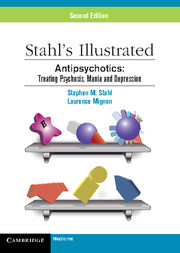Book contents
- Frontmatter
- Preface
- Contents
- CME Information
- Objectives
- Chapter 1 Neurobiology of Schizophrenia and Mood Disorders
- Chapter 2 Multifunctionality of Antipsychotics
- Chapter 3 Side Effects of Antipsychotics: Metabolic Issues and Sedation
- Chapter 4 Individual Antipsychotic Drugs
- Chapter 5 Schizophrenia Pharmacy and Switching Strategies
- Summary
- Abbreviations and Symbols
- Suggested Reading
- Index
- Continuing Medical Education Posttest
- Activity Evaluation
Chapter 2 - Multifunctionality of Antipsychotics
Published online by Cambridge University Press: 19 October 2021
- Frontmatter
- Preface
- Contents
- CME Information
- Objectives
- Chapter 1 Neurobiology of Schizophrenia and Mood Disorders
- Chapter 2 Multifunctionality of Antipsychotics
- Chapter 3 Side Effects of Antipsychotics: Metabolic Issues and Sedation
- Chapter 4 Individual Antipsychotic Drugs
- Chapter 5 Schizophrenia Pharmacy and Switching Strategies
- Summary
- Abbreviations and Symbols
- Suggested Reading
- Index
- Continuing Medical Education Posttest
- Activity Evaluation
Summary
The serendipitous discovery in the 1950s that the antihistamine chlorpromazine can relieve symptoms of psychosis led to the discovery of conventional antipsychotics. Their ability to block D2 receptors was recognized by the 1970s. Since then, much research has been done to improve antipsychotic medications. This chapter explores the different classes of antipsychotics, explains their mechanisms of action, and describes how they affect the brain circuitry in schizophrenia and in mood disorders.
Additional properties have been integrated into the newer medications to improve therapeutic efficacy and prevent/reduce drug-related side effects. This table provides an overview of the different types of antipsychotics used to date.
This D2 antagonism will lead to a reduction in both the hyperactivity of this pathway and the positive symptoms linked to it.
However, the mesolimbic DA pathway is not the only pathway affected by D2 antagonists.
As the PFC does not have a high density of D2 receptors, the worsening of negative symptoms might also result from a deficient mesolimbic DA pathway.
In order to treat both positive and negative symptoms it is important to decrease DA activity in the mesolimbic pathway and increase DA tone in the mesocortical pathway. Dopamine function in schizophrenia is not simply “too high” or “too low;” it might be “out of tune.” Thus today's psychopharmacologist needs to learn how to tune the system adequately.
A lack of DA in this pathway results in movement disorders such as rigidity, akinesia, bradykinesia, and tremor, all hallmarks of Parkinson's disease.
A surplus of DA in this pathway, on the other hand, results in hyperkinetic movement disorders such as chorea and dyskinesia. Blockade of D2 receptors, such as with a conventional antipsychotic, prevents DA from binding there and can lead to motor side effects that are often collectively termed extrapyramidal side effects (EPS).
Every year, 5% of patients on conventional antipsychotics will develop tardive dyskinesia (25% of patients will be affected by 5 years), and for a disorder that starts in the early 20s, these odds are not acceptable.
Removing the conventional antipsychotic in time can prevent the occurrence of tardive dyskinesia, as this will allow the D2 receptors to lose their sensitivity and downregulate.
- Type
- Chapter
- Information
- Stahl's Illustrated AntipsychoticsTreating Psychosis, Mania and Depression, pp. 31 - 88Publisher: Cambridge University PressPrint publication year: 2010

